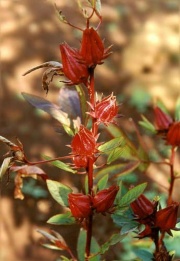Roselle
Description
Bast fibers obtained from the stems of the Hibiscus sabdariffa plant that is grown commercially in Central and South America, Brazil, Africa, West Indies, and the East Indies. Roselle is used as a substitute for jute in burlap coffee bags. Roselle is sometimes called kenaf because of its similarities. The dried red calyces are also used as a colorant in food products.
Synonyms and Related Terms
rosella; kenaf; Siam jute (Thailand); mesta (India, Pakistan); ke-nap (Vietnam); carcadé (Fr.); bissap (Fr.); wanjo (Gambia); zobo (Nigeria); karkarde (Egypt, Sudan); omutete (Namibia); sorrel (Caribbean); jamaica (Latin America); vinagreira (Port.) quiabo-roxo (Port.)
Other Properties
Bush growing to 2-3 m tall. Leaves=three to five deep lobes (8-15 cm long). Fiber cross section = polygonal
Additional Information
G.Cook, Handbook of Textile Fibres:I. Natural Fibres, 5th edition, Merrow Publishing Co., Durham, England, 1984.
Sources Checked for Data in Record
- Marjory L. Joseph, Introductory Textile Science, Holt, Rinehart and Winston, Fort Worth, TX, 1986
- J.Gordon Cook, Handbook of Textile Fibres:I Natural Fibres, Merrow Publishing Co. , Durham, England, 1984
- Identification of Textile Materials, The Textile Institute, Manchester, England, 1985
- Wikipedia, the free encyclopedia, at http://www.wikipedia.com Comment: http://en.wikipedia.org/wiki/Roselle_%28Plant%29 (Accessed Feb. 2, 2006)
- G.S.Brady, Materials Handbook, McGraw-Hill Book Co., New York, 1971 Comment: p. 427
- Richard S. Lewis, Hawley's Condensed Chemical Dictionary, Van Nostrand Reinhold, New York, 10th ed., 1993
- Random House, Webster's Encyclopedic Unabridged Dictionary of the English Language, Grammercy Book, New York, 1997
